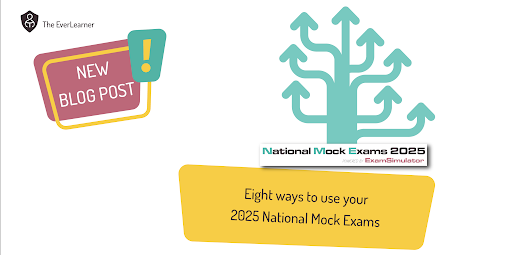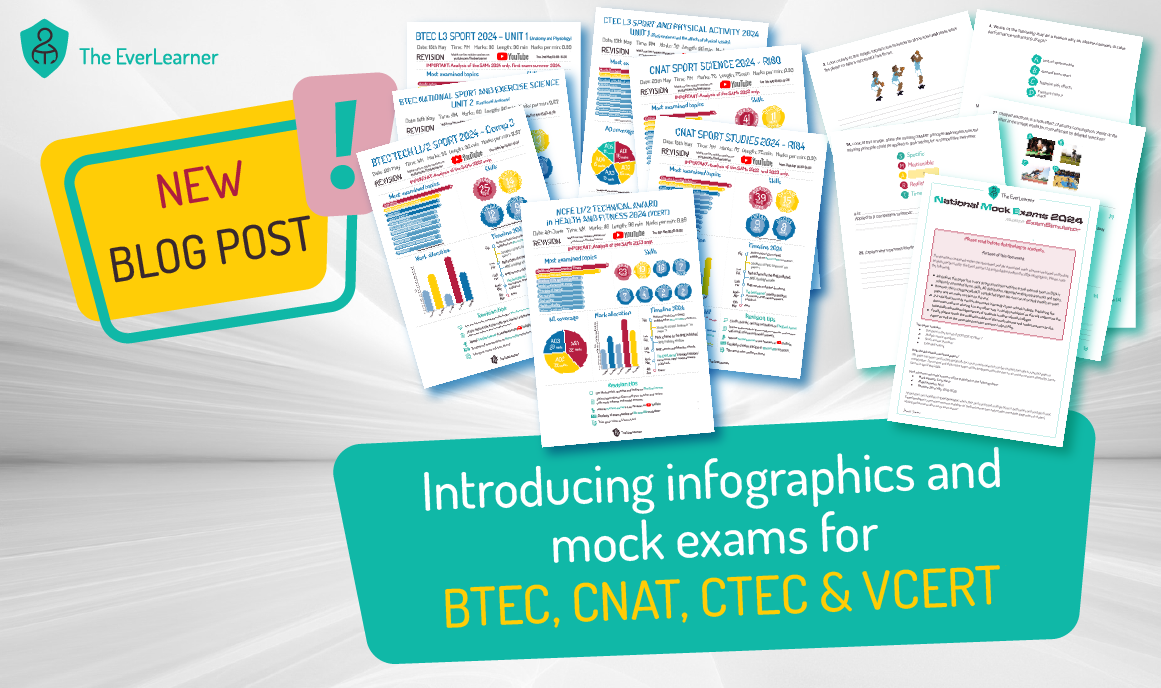Five types of exams you need to use in your PE classroom - Part 3 of 3
In the last two weeks, I have been publishing about types of exams that PE teachers can use within their examination PE lessons to improve the examination skills of students.
In Part 1, I wrote about collaborative exam practice and shared lots of practical ideas about how to scaffold the earlier stages of students’ experiences. I wholeheartedly endorse these models and I really hope that a tonne of PE teachers will take them seriously and implement them.
In Part 2, I wrote about skill-based exams as well as interleaved exam practice. Once again, I thoroughly endorse these processes and I hope you may choose to adopt them. If you do, your students will perform better, on average, in exams.
This week, I’m going to write about “Cut-and-paste exams” and about time-restricted exam practice. Once again, I hope these are practices that you can implement efficiently and that your students can rely upon.
Let’s get stuck in:
Exam type 4: Cut-and-paste exams
As a PE teacher of the 00s and 10s, I have guillotined and Pritt-sticked my fair share of exam papers and mark schemes. I reckon I have spent at least tens of hours in reprographics rooms slicing and splicing, and glueing and copying. Thankfully, those days are pretty much behind us and there are smarter ways to construct exams. Take my own ExamSimulator software, for example: there you can make whatever type of paper and mark scheme you wish and the computer will do the vast majority of the work for you.
Cut-and-paste exams remain a little bit old school. They require students to successfully build mark schemes and then answer questions based on those mark schemes. Here’s how it works:
Build a paper and mark scheme. Here’s a video of me doing that:
Once this paper and mark scheme are constructed, it is time to start cutting. When you cut, the idea is that you are deconstructing a question and/or a mark scheme. You can cut away or separate any of the following elements:
From the question:
- The command word
- The mark total
- The number of lines
From the mark scheme:
- Lines of marking points
- The AO reference numbers
- The marking guidance
- Any individual word or phrase
Once you have done this, the entire paper (with its cutaway elements) and the entire mark scheme (with its cutaway elements) can be placed into an envelope or container and, once handed out in class, requires the students to reconstruct or “paste” the questions and mark schemes.
Imagine, for example, a student having to determine which question should be allocated nine marks. Imagine, for example, a student having in the region of 10 marking points as cutaways and having to determine their position in the whole mark scheme. These processes really help to get the students familiar with question and mark-scheme formats and what each reference means.
Once this activity has been done, it is a good idea to either glue everything together and have the student use the pasted versions or, more likely, give the students a fresh, full copy that they can now complete. This full version can be completed in any of the other exam formats that I have written about in this series of blogs, whether it is idea piles or pass the buck. Whatever works! But, crucially, you should find that your students are now very aware of both the question formats AND the requirements of the mark schemes. This is an excellent model to scaffold your learners, especially when reviewing a topic or skill.
Exam type 5: Time-restricted exams
It is my contention that time restrictions are very, very poorly utilised in PE classrooms. Whilst it is impossible for this claim to be anything more than anecdotal by its nature, I am going to make two claims to this end:
- Time restrictions are mostly used when a time restriction is not helpful to learning and assessment in PE lessons.
- When learning and assessment would be aided by time restrictions in PE lessons, time restrictions tend not to be used or are poorly used.
It’s important to note that I am referring above to time restrictions in general, rather than specifically to time-restricted exams, which I will come to lower down. But, remaining general at this point, time restrictions are used well and poorly as follows, in my opinion:
|
Poor uses of time restrictions |
Good uses of time restrictions |
|
When teaching/instructing such as “I will teach this to you once at my teacher pace.” |
When a student is completing a “temporal assessment”. Temporal assessments tell us (student and teacher) “What I was capable of at this moment.” |
|
When students engage in a classroom activity such as “Here’s a worksheet. You have 10 minutes.” |
When a student is completing a test or checkpoint quiz which can be retaken any number of times until mastery is reached. |
|
When students should be allocated extra time due to access arrangements within an assessment and they are not. |
When a student is completing a mock or external exam. |
|
When a student has been allocated their extra time for reasons of access arrangement in any of the contexts above. |
I am going to ask you to reflect here. Really reflect! When do you –when do we all– commonly use time restrictions in classrooms? I am arguing that we use them far more commonly weighted to the left-hand column. We use them poorly far, far too often. We use time restrictions when we instruct from slides. We use them during a class task. We use them anytime that we state something along the lines of “Right. Despite you not mastering that yet, it’s time to move on.” We collectively need to challenge these time restrictions, as they are falsely and artificially imposed on students.
Now, let's look at time-restricted exams. Your students, like mine, will be externally assessed in time-restricted environments. Therefore, this is a key skill set of your and my course. Develop it! It’s easy for me to say things such as “Your core assessments should be time-restricted.” This is obvious. I’m sure you do this. I want to go further here. Time restrictions are really, really beneficial in association with other variables. For example, time restrictions are inversely proportional, to some degree, to the rigour of a task. Let me show you how:
- Build an exam question(s) and mark scheme(s).
- Put the question(s) on the board.
- Use a stand-and-stare methodology (I will provide details below) to have your students try to remember key aspects of key phrasing, a drawing, a mark scheme or even a model answer. This must be done under very strict time restrictions.
- Provide a strict time restriction for students to further familiarise themselves with what they have produced.
- Once done, remove or turnover the materials that would help them answer the question.
- Probably in silence and probably in isolation/exam conditions, have the students write their answers based on what they can remember.
If you look at this set-up, I have made the task pretty easy. Before students write an answer, I make them engage with and, potentially, even memorise key resources that could provide an answer in a gamey-type way. In my case, with stand and stare (see below). But, crucially, the students are under time pressure, which forces them to actively memorise concepts, definitions, explanations, examples and evaluative points. They then have to rely on this produced and remembered content to reproduce their own answer under exam-like conditions. One could summarise this process as:
- Expose.
- Collaborate.
- Remember.
- Write/Draw (depending on the question command).
A note about memorisation
Memorisation is a process and it overlaps with other, meaningful aspects of learning. Unless the items to be memorised are completely meaningless (See Ebbinghaus’s work), memorisation, done well, can improve conceptual understanding, evaluative and analytical skills. Try to view memorisation exercises as functional if structured well. Memorising is a positive and educational process when the objective of an activity is contextual encoding and efficient retrieval. Furthermore, storing key language and subject vocabulary in the long-term memory provides students with the potential to develop better exam technique.
This would not work without time restrictions.
There are hundreds of nuanced ways to tweak what I have recommended but my point remains: time restrictions and exam practice rigour are inversely proportional UNLESS we are conducting a formal assessment. If I add a time restriction, I can “de-rigour” or, more accurately, scaffold the process of writing. Also, anecdotally, students love these processes. They enjoy the game aspect of it but, more importantly, they learn critical skills such as mark-scheme usage, memorisation and reproduction.
What the hell is stand and stare?
I didn’t actually intend to write about this activity. It is a banger!!!! I use it a lot. Stand and stare is a memorisation activity that is particularly useful for visual stimuli and longer-format linguistic stimuli such as mark schemes or model answers.
It works like this:

And here’s a little CPD session on it:
Conclusions
So, there you have my five types of exam practice. As I conclude this writing, I feel like I have only scratched the surface and have missed out far more than I have included. I have built these practices over 27 years of teaching and they are fundamental to my work. I also just love them because the students respond well and because I see them progressing.
Whenever I write these blogs I try to avoid simply telling you what you’re likely to know. Instead, I try to throw different applications or deeper reflections that I have had at you. For example, telling you to time-restrict some exams is pretty obvious but, above, I have tried to provide a detailed way of using time restrictions to cause, in this case, memorisation and mark scheme skills. I hope that’s useful to you.
Finally, whenever I complete these blogs, I always end up feeling that I should be writing more. I am seriously interested in writing a book for the PE teaching sector and specifically focusing on qualification-based PE. What do you think? What would you value?
Thank you for reading and have a lovely day.
James
%20Text%20(Violet).png)


